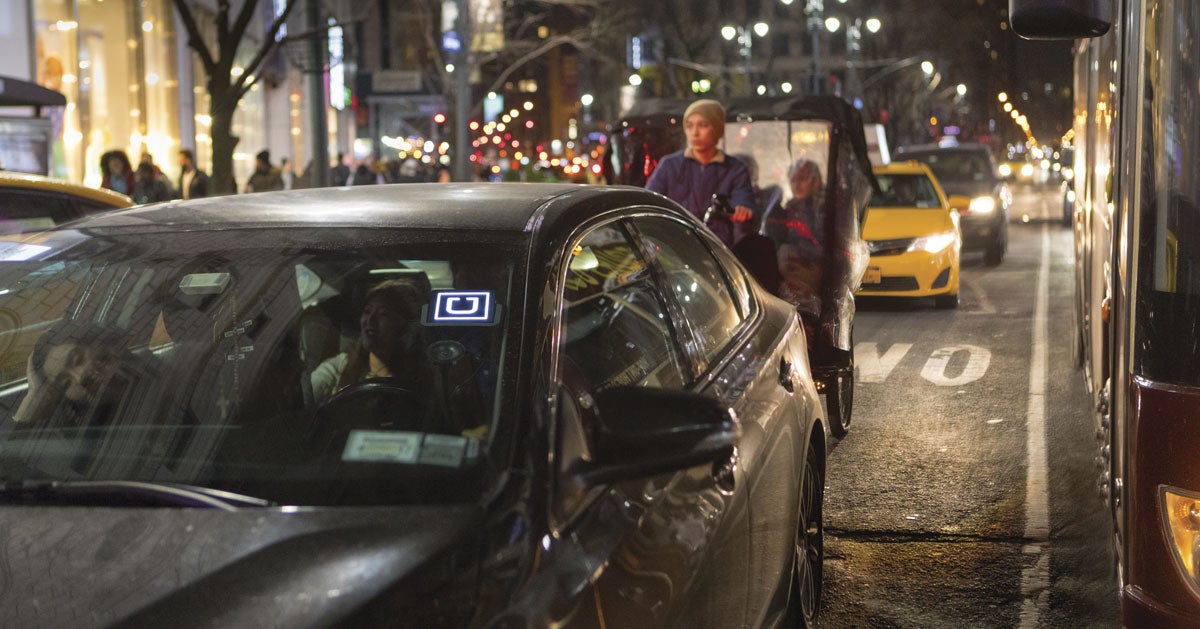Should states be able to tax outside their borders? In South Dakota v. Wayfair, the Supreme Court dropped its physical-presence standard that had prevented states from taxing sales between their citizens and out-of-state retailers. States had claimed internet commerce was eroding their revenues, making the standard unworkable. Adam Michel and Elizabeth Slattery write:
[Overturning] the physical presence standard in Quill and [expanding] state taxing powers risk[s] undermining foundational principles of competitive federalism while increasing compliance burdens on small businesses.
Permitting interstate tax collection [will] undermine local business owners’ ability to vote on tax laws that affect them. Without a physical presence standard, local Oregon e-retailers [will] suddenly have to comply with every sales tax law in over 10,000 state and local taxing jurisdictions. If states wish to impose costs on retailers within their borders, they should be able to do so. However, retailers should not be subject to mandates from states with which they have no physical connection—and whose policymakers face no accountability for the tax and regulatory costs they impose.
Interstate taxation [will] also introduce a new disparity. Local brick-and-mortar stores have only the compliance burden of their state and local tax systems. Expanded interstate taxes [will] subject remote sellers to tax systems in every state in which they have a customer. The compliance burdens for online retailers could be prohibitively expensive. [Internal citations omitted.]
[Adam Michel and Elizabeth Slattery, “Do Borders Matter? The Supreme Court Reviews Internet Sales Taxes,” The Heritage Foundation, April 12]
Shipping protectionism has increased the danger of cargo voyages. Thomas Grennes writes:
The Jones Act of 1920 requires, among other things, that cargo voyages between two American ports must use American-built ships. As the United States has lost its comparative advantage in ship-building, U.S. ships have become more expensive, and the average age of ships in the Jones Act–eligible fleet has risen relative to the average age of foreign-flag ships. Older ships are less safe, and reforming the Jones Act is the key to increasing safety in U.S. shipping. […]
A group at Southampton Solent University conducted a comprehensive study of ship accidents taking place in the last 15 years and concluded, “The evidence confirms the hypothesis that most ship accidents can be linked with older vessels. …” The average age of vessels lost was consistently above 20 years, and the average age of lost ships increased steadily over the sample period. […] U.S.-flag ships are older than those of the world fleet, and the Jones Act contributes to the extraordinary aging of the U.S. fleet. The average age of ships in the U.S. fleet (33 years) is greater than the average age of ships in the foreign-flag fleet (13 years).
[Thomas Grennes, “Sacrificing Safety Is an Unintended Consequence of the Jones Act,” The Mercatus Center, March 21]
Uncontrolled drug prices are the solution, not the problem. Scott Atlas writes:
Four times as many life-saving cancer drugs were first made available in the United States compared to countries like Germany, Japan, Switzerland, France, Canada, Italy, and the UK, as reported in the Annals of Oncology in 2007. Similarly, 29 of the 45 novel drugs approved by the [Food and Drug Administration] in 2015 were approved in the United States first. Most recently, a 2017 study of 45 FDA-approved new cancer drugs found that all of them were covered by Medicare in the United States, while only 26 were approved and covered in the UK, 19 in France, 13 in Canada, and only 11 in Australia.
This early and broad drug access is a key reason why America has better treatment results compared to nationalized systems elsewhere, where drug prices are strictly regulated by government, for virtually all serious diseases reliant on drugs, including cancer, heart disease, stroke, and the most important chronic disorders, including high blood pressure and diabetes.
Not surprisingly, prices and profit margins for prescription drugs in the United States dwarf those in foreign markets. This discrepancy may seem unfair, yet it is undoubtedly a key incentive for the constant innovation and first access to life-saving drugs that Americans enjoy.
[Scott Atlas, “An Overlooked Key to Lower Drug Prices,” Hoover Institution, April 4]
In 2000, 17 million people were dependent on food stamps, costing taxpayers roughly $17 billion annually. By 2016, enrollment had reached 44 million, with costs exploding to $70 billion per year.
Welfare reform is needed again. Sam Adolphsen, Jonathan Ingram, and Josh Archambault write:
In 2000, 17 million people were dependent on food stamps, costing taxpayers roughly $17 billion annually. By 2016, enrollment had reached 44 million, with costs exploding to $70 billion per year. Much of this growth is being driven not by seniors, poor children, or individuals with disabilities, but instead by able-bodied adults.
Under federal law, able-bodied adults who are between the ages of 18 and 50 and who have no dependents are required to work, train, or volunteer at least 20 hours per week to maintain food stamp eligibility after three months. Although work registration and optional workfare requirements have been part of federal law for many years, the 1996 welfare reform created a new time limit for able-bodied childless adults as a way to reorient the program toward work.
But the law exempts all parents and able-bodied, childless adults over 50 from these commonsense requirements. While some of these adults are subject to a separate requirement to participate in employment and training programs if assigned, few states ever assign them to such programs, rendering the requirement virtually meaningless.
If that weren’t bad enough, regulatory guidance has allowed and even encouraged states to use gimmicks and loopholes to keep as many able-bodied adults on the program as possible. These waivers, originally intended only for areas with high unemployment, have been expanded to the point of absurdity. More than a third of the nation lives in an area where work requirements are waived, despite record-low unemployment and more than 6 million open jobs across the country. Those loopholes let states like California—with nearly 560,000 open jobs and a record low unemployment rate—waive work requirements in every corner of the state, even in cities with unemployment rates as low as 2.1 percent.
[Sam Adolphsen, Jonathan Ingram, and Josh Archambault, “6 In 10 Able-Bodied Food Stamp Recipients Do Not Work At All. That Has To Change,” The Federalist, May 3]
 credit: PICTURE ALLIANCE/FRANK MAY/NEWSCOM
credit: PICTURE ALLIANCE/FRANK MAY/NEWSCOM
Union-backed study finds unions aren’t attractive to workers. In Janus v. American Federation of State, County and Municipal Employees the Supreme Court ruled that the agency-fee set-up that governs public employment in 22 states violates the First Amendment rights of workers who do not wish to belong to a union. Prior to the decision, Eric Boehm reported that the unions themselves had studied what would happen if workers had a choice:
The Illinois Economic Policy Institute estimates that 726,000 workers would choose to stop paying dues if they had that choice, which public sector workers in many states currently do not. That could change after the U.S. Supreme Court announces a ruling—likely to come next month—in the much watched Janus v. AFSCME case. […]
A ruling in Janus’ favor could require unions to do what all other non-government entities already have to do: convince people to voluntarily support their activities.
[Eric Boehm, “Unions Could Lose 726,000 Members if Mark Janus Wins His Supreme Court Case,” Reason, May 10]
The Illinois Economic Policy Institute estimates that 726,000 workers would choose to stop paying dues if they had that choice, which public sector workers in many states currently do not.
Universal basic income will cost a lot, shift resources from the poor, and undermine work. Robert Doar writes:
A truly universal payment of $10,000 to every citizen every year adds up to a new expense of about $3 trillion, well more than we spend on our social safety net now, and close to the entirety of the tax revenue currently collected by the federal government.
If any element of the current safety net is going to be preserved, taxes will have to be raised dramatically, beyond what is politically plausible or economically desirable, or the U.S. would have to borrow even more money than we already do. Proponents of UBI should have to answer: what social programs will be cut to make room for their proposal? […]
[I]n the major study of UBI-like programs provided in Seattle and Denver, substantial, unconditional payments were found to cause a near 14 percent decline in labor force participation, and a 27 percent reduction in hours worked by women. That’s a labor force drop-off greater than the difference between the highest participation rate we’ve ever seen in this country and the lowest.
That doesn’t only mean people will be less driven than ever to earn their way out of poverty. Less work also means fewer “feelings of citizenship and social inclusion,” worse mental health and feelings of wellbeing, less happiness, worse self-esteem, even worse health among children, more crime, and way more drug abuse. The benefits of working are vast and well-documented, and anti-poverty programs should encourage work—not discourage it.
[Robert Doar, “Universal Basic Income Would Undermine the Success of Our Safety Net,” The American Enterprise Institute, May 17]
States are innovating to lower health care costs. Getting a waiver from Obamacare’s insurance market regulations is the first step, writes Robert Moffit:
Alaska secured a 1332 waiver that enabled officials to redeploy federal subsidies and re-channel those funds into a risk pool for high-cost enrollees and thus stabilize its market. The result: Alaska reduced individual market premiums by a stunning 25 percent.
Likewise, Gov. Scott Walker of Wisconsin signed legislation to apply for a waiver to create a reinsurance program that would cover 80 percent of high-cost claims. Under the waiver, the state would use federal dollars to cover 75 percent of the cost and state taxpayers would fund the remainder. Wisconsin officials project a 13 percent premium reduction in 2019 and 12 percent in 2020.
Gov. Larry Hogan of Maryland also recently signed bipartisan legislation authorizing a waiver and creating a reinsurance program. While Maryland would impose a small premium tax to finance its reinsurance program to finance high-cost claims, Maryland officials are hoping to cut individual market premiums “in half.”
State officials using these waivers from current law can stabilize their markets, reduce premiums, and provide relief to individuals and families currently entrapped in severely damaged individual and small group health insurance markets. […]
Federal waivers and reinsurance initiatives are, however, only a partial answer to the multi-faceted crises in the various state health insurance markets. Under Obamacare, the elected representatives of the people of the states are still largely hamstrung in their efforts to secure market innovations, inasmuch as they still are little more than supplicants for federal regulatory relief.
[Robert Moffit, “States Are Offering Relief from Rising Health Care Costs. Here’s How Congress Can Help,” The Daily Signal, May 23]
 credit: NYCSHOOTER/GETTY IMAGES
credit: NYCSHOOTER/GETTY IMAGES
Ride-sharing helps lower health care costs. Leon S. Moskatel and David J. G. Slusky write:
Unnecessary ambulance use (when the patient could have taken a less expensive means of transportation without a reduction in health outcome) is partially due to lack of alternatives. Recently, though, alternatives have become available. Many individuals have started to seek cheaper transport from ride-sharing services such as Lyft and Uber. In addition, while ambulances prioritize patient safety and typically insist on transporting a person to the nearest hospital, ride-sharing cars allow the patient to pick which hospital to go to. This is important because farther facilities can have differing results for the same condition. Also, the closest hospital may not be in network for the patient, and therefore directing a ride-sharing vehicle to a farther hospital would lower the hospital bill itself as well. […]
There is at least a 7 percent decrease in the ambulance rate from the time of UberX entry into a city. Given that this decrease happened so soon after the UberX introduction, ambulance companies likely did not adjust the size of their fleets, so UberX entry likely also led to a reduction in the time spent waiting for an ambulance for the remaining volume. Because a reduction of a few minutes can drastically improve the odds of survival for many serious conditions, that decrease could have caused a substantial reduction in loss of life.
[Leon S. Moskatel and David J. G. Slusky, “Does Ride-Sharing Substitute for Ambulances?” Cato Institute, May 23]
Armed citizens can make a difference, and as more Americans obtain carry permits, more Americans will be on-scene and able to react.
Armed citizens increasingly are stopping mass shootings. David French reports some findings from the FBI’s April 2018 report on active shooter incidents:
From 2000 to 2013, only five times did an armed citizen (who was not a police officer) exchange fire with the shooter. Three times the citizen killed the shooter, once the shooter committed suicide, and once the shooter was wounded. Fast forward to 2016–2017. In that time period, six armed citizens confronted active shooters. They stopped the shooting four times (in one case, the shooter fled to a different site and continued shooting, and in the other the armed citizen was wounded before he could stop the shooting).
The lesson? Armed citizens can make a difference, and as more Americans obtain carry permits, more Americans will be on-scene and able to react. Moreover, what’s missing from the data is any indication that armed citizens make the crisis worse. The stereotype of carry-permit holders spraying panicked gunfire is simply wrong.
[David French, “New FBI Data on Active Shooters Shows the Importance of Armed Citizens,” National Review, May 25]
 credit: GETTY IMAGES
credit: GETTY IMAGES
Less free, more lies. Charles Hughes writes:
A recent working paper from Luis R. Martinez of the University of Chicago uses a novel data set of satellite imagery and finds that yearly GDP growth rates in the most authoritarian regimes are inflated by between 15 and 30 percent. […]
In a previous study in the American Economic Review, the authors developed a statistical framework to use satellite images to estimate growth. To answer the question of whether authoritarian countries were manipulating official GDP statistics, Martinez compared reported GDP figures to satellite images of night time lights. While governments might be able to influence or change reported figures, it would be difficult or impossible for them to similarly affect satellite imagery. […]
A topline comparison of average growth rates in night lights and GDP reveals that the same amount of growth in night lights translates to a significantly higher amount of GDP growth in more authoritarian countries. […]
Using raw GDP, only 4 of the 20 countries that had the highest aggregate growth from 1992 to 2008 were classified as “free” by Freedom House, compared to 5 being “partially free” and 11 that were “not free.” After correcting for the data manipulation in authoritarian regimes, 9 of the countries in the top 20 were “free.”
[Charles Hughes, “Satellites to Authoritarian Regimes: Your GDP Is Inflated,” e21, May 22]
ROUND UP highlights key work produced by conservative and classical liberal think tanks. Submit ideas at [email protected]
